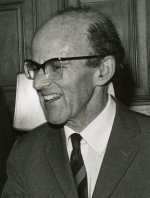William T. Astbury
Oswald T. Avery
Sir William Lawrence Bragg
Erwin Chargaff
Martha Chase
Robert B. Corey
Francis H. C. Crick
Max Delbrück
Jerry Donohue
Rosalind Franklin
R. D. B. (Bruce) Fraser
Alfred D. Hershey
Linus Pauling
Peter J. Pauling
Max F. Perutz
J. T. (John Turton) Randall
Verner Schomaker
Alexander R. Todd
James D. Watson
Maurice H. F. WilkinsView all Key Participants
|

Portrait of Max Perutz. April 6, 1976.
More Info
Max F. Perutz1914-2002
The papers of Max Ferdinand Perutz
Location: Churchill Archives Center, Churchill College
Address: Cambridge, CB3 0DS, United Kingdom
Size: 45 boxes
Finding Aid: http://www.chu.cam.ac.uk/archives/collections/full.php#PERUTZ
Phone: 44-1223-336087 Fax: 44-1223-336135
Email: archives@chu.cam.ac.uk Web: http://www.chu.cam.ac.uk/archives/
Correspondence
Pictures and Illustrations
Published Papers and Official Documents
Manuscript Notes and Typescripts
Quotes
"So much good work has come from the Medical Research Council unit in Cambridge under
Perutz and Kendrew that I think it deserves the recognition of a Nobel Prize. I have
drafted a form of recommendation and I am enclosing the draft for your comments. I
need hardly say how much strength would be lent to it if you felt able to give your
support.
The two main things are the body of work by Perutz and Kendrew which may now be fairly
claimed to have succeeded in getting out the structure of two protein molecules, and
incidentally shows how large a part of your d helix plays in it; and in the second
place there is the work on nucleic acid by Watson and Crick. Each of these, it seems
to me, is of Nobel Prize standard.
One must also take into consideration a number of other important contributions from
the laboratory, such as the work on virus, on sickle-cell anaemia, the beginning of
Huxley's work on muscle, and the work on collagen; it is an impressive record. As
an alternative I thought it might be well to suggest that the work of the unit as
a whole should be recognized by dividing a prize between its four leaders, Perutz,
Kendrew, Watson and Crick. Here I should be especially glad to have your views."
W.L. Bragg. Letter from Sir Lawrence Bragg to Linus Pauling. December 9, 1959.
"I might say that it reached a very pleasant climax at a conference that Linus Pauling
had arranged to take place in Pasadena in 1953. Nowadays we would call it a workshop,
on the structure of biologically important molecules: it probably wasn't attended
by more than 25 or 30 people...The conference was strictly limited to structure; but
in that respect, it was quite spectacular. It included Watson and Crick's account
of the structure of DNA, solved six months earlier..."
Max Perutz. Interview with Horace Freeland Judson December 1970.
"Pauling's textbook on the chemical bond changed the way scientists thought about
chemistry, presenting chemistry as a disciplinary field unified by an underlying theory.
By demonstrating how the characteristics of the chemical bond determined the structure
of molecules and how the structure of molecules determined their properties, Pauling
showed for the first time, as Max Perutz said, 'that chemistry could be understood
rather than being memorized.'"
Mary Jo Nye. "Was Linus Pauling a Revolutionary Chemist?" Bulletin for the History of Chemistry, 25: 76-77. 2000. Audio Clips
Video Clips
|

